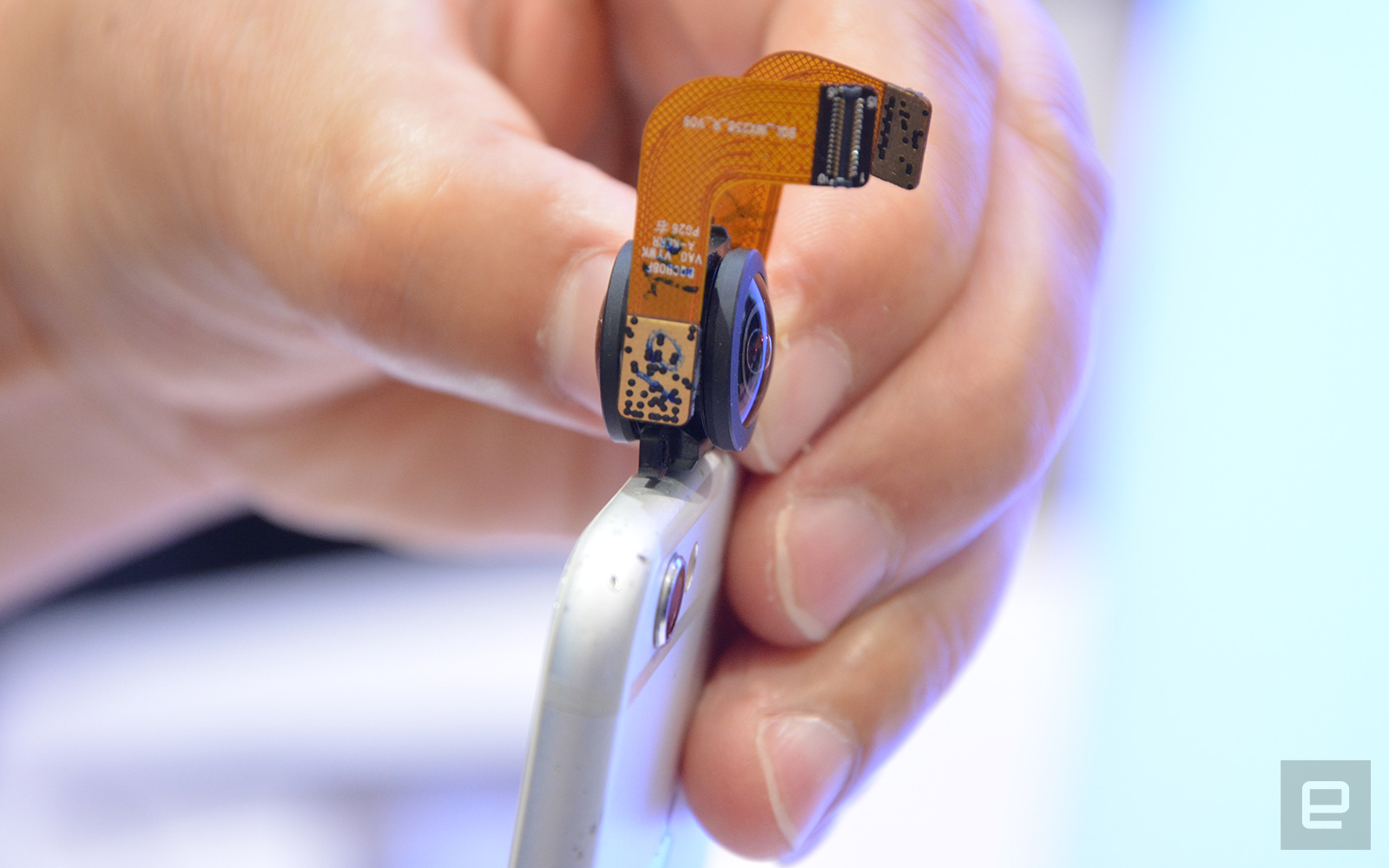
Huawei is making another virtual reality video camera. Huawei released the Honor VR camera in China 6 months ago. This clip-on 360 degree camera has been developed in partnership with...
 You're probably not aware of this, but a Chinese company dubbed ProTruly has already released the world's first two smartphones with a built-in 360 camera last December. Don't worry if you missed the news, because chances are you'd be put off by the...
You're probably not aware of this, but a Chinese company dubbed ProTruly has already released the world's first two smartphones with a built-in 360 camera last December. Don't worry if you missed the news, because chances are you'd be put off by the...
The Motrr Galileo is a nifty device for those who want to get more out of their smartphone’s camera. This compact gadget provides iPhone users with the ability to capture motion-control video effects, as well as other types of remote camera capabilities.
The Galileo is about the size of a thick hockey puck, but it’s actually quite powerful. The device works in concert with a variety of apps which can do everything from motion time-lapse video, to remote-controlled teleconferencing. It can be set on a tabletop or attached to a standard screw-thread tripod for optimal stability in the field.
Using the Galileo is easy. Simply choose the proper device insert for your iPhone or iPod Touch, and plug it into a USB charger to wake it up the first time, then load the Motrr app onto your smartphone to pair it and learn about compatible apps. Once you’ve selected an app to use with the Galileo, just twist the device, and it will ask to connect within the app. The Galileo is available in either a 30-pin ($99.95) or Bluetooth version ($149.95) – which is the model I’m using.
There are a wide variety of apps available, which you can check out on the Motrr website. My two favorites (so far) are TimeLapse, and Sphere. TimeLapse does what you’d expect, automatically capturing time-lapse video from still images, but making it really easy with pre-sets for common time-lapse scenarios. By combining this with the motion-control aspect of the Galileo, you can create sophisticated time-lapse which usually require much more expensive equipment. One thing to keep in mind with time-lapse footage is that you’ll want to make sure both your camera and the Galileo have enough battery charge, and you’ve temporarily disabled notifications.
Sphere is really cool too. It can capture a 360° panoramic image in under a minute. All you need to do is set your iPhone in the Galileo’s dock, and press the touchscreen. Sphere works in concert with the Galileo to capture all of the images needed, then stitch them together into a panorama you can view directly on your phone or share on the Internet. You can see a sample Sphere I shot below. It’s not perfect with aligning horizontal lines like the ones in the siding, but it’s still pretty nifty.
One thing that’s tricky to do with the iPhone is capture a perfectly smooth panoramic image. Using the DMD Panorama app with Galileo, you can capture foolproof circular panoramas in full photo resolution. Click the icon in the upper right corner of the image below to pop open a full-res panorama captured with the Galileo and this app, or click here for the original hi-res image.
One other app I tested with the Galileo was Videography. This app is great for shooting HD video of motion or faces, since it can automatically track these and pan and tilt the camera accordingly, though the motion tracking has a tendency to be a bit jerky compared to the face and color tracking, which seemed to offer smoother movements.
There are a number of other apps I didn’t get a chance to try, but it’s clear that the Galileo offers much more versatility than its simple premise might suggest. For instance, I wouldn’t have thought about using the Galileo’s platform to create a motorized alarm clock. You can also use it for automated home monitoring – assuming you have a spare iPhone or iPod Touch to use.
While not everyone will find a daily use for the Motrr Galileo, anyone who enjoys photography or has a need for remote telepresence will get plenty of value for the price.

Your phone is likely able to take a panoramic shot. Sweet, right? Well, really, it’s just sort of ok. For one, you have to learn how to take that shot, slowly panning and keeping your hand stable. Secondly, if anything is moving across your field of view as you take it, you end up with headless bodies and other hilarious artifacts. Not to mention, you’ll be lucky to get 160-180 degrees in one picture. Ricoh does away with all that noise with the Theta. It features two back-to-back lenses which capture 360 degrees at the single press of a button. Software on your smartphone or PC/Mac then lets you view and explore the pictures you take. It’s a pretty interesting innovation, even if it’s not one for every occasion. If you expect to be out, exploring scenic settings, you may want to have Theta around. If you’re just going to the club, carrying a second digital device might not be worth it. Granted this creates a smaller niche market, and at $399, might be a tough sell for many. Still, it’s nice to know this exists and if it’s your cup of tea, it’ll be available later this month.
[ Product Page ] VIA [ DamnGeeky ]
A wild spherical camera appears! Actually it’s not the first of its kind that we’ve seen, but unlike the previous device, Serveball’s Squito is being designed for both professional and recreational use. Forget about Instagram or Vine, the cool kids will want to get ball shots! Yeah! No.

According to Serveball’s press release, the current prototype of Squito has three cameras, an inertial measurement unit, a microcontroller and an image processor. As you’ll see in the video below, the prototype can take 360º panoramic pictures and videos. When taking pictures, the Squito can reorient and stitch the images that its cameras take. When shooting a video, the Squito can stabilize the video, but don’t expect a free falling camera to be as steady as one on a tripod. The Squito will also be able to wirelessly send its pictures and videos to PCs and mobile devices.
The tail end of the video featured a version of the Squito with night vision and thermal imaging capabilities. From what I can tell those features will be on a separate variant of the Squito, which Serveball is calling the Darkball. Fold your browser into a ball and throw it to Serveball’s website for more on its cameras.
[via Engadget]
In Insert Coin, we look at an exciting new tech project that requires funding before it can hit production. If you'd like to pitch a project, please send us a tip with "Insert Coin" as the subject line.
The problem with capturing panoramic stills with your phone is that you need to keep a steady motion when panning around, but we all know that only a robot can perform such feat perfectly. That's why this little BubblePod caught our attention. The device is essentially a mini clockwork turntable so no battery is required -- just wind it up, slip an iOS, Android or BB10 device into the silicone grip, fire up the BubblePix app and hit the BubblePod's release button for a steady 40-second rewind.
The sample panoramic shots (or "bubbles") we saw have almost no visible stitching, and the app can simultaneously record an audio clip to capture the atmosphere as well. Better yet, in addition to its rubberized base, the BubblePod is also built with a universal tripod mount plus a wine bottle insert mount!
This Kickstarter project will offer a unit if you pledge a minimum of £15 (about $23) for the limited early bird offer or £20 (about $31) later on, plus £5 (about $8) to ship outside the UK. Do check out the demo video after the break, and feel free to grab yourself a BubblePod before funding ends on July 9th.
Filed under: Peripherals, Mobile
Source: Kickstarter
We’re seeing more and more cameras that can take – or at least put together – 360º panoramic images. This prototype made by Ricoh is another example. It has two fisheye lenses that can each cover 180º. The camera will automatically combine the images from each half to create a full 360º image.

But the camera itself is just one part of Ricoh’s project. After it processes an image, the camera will upload it to a mobile device using Wi-Fi, so users can immediately view and play with the picture.
We’re gonna need a bigger picture frame.
[via DigInfo.TV via Akihabaranews]

Not all Kickstarter projects take flight, to say the least, so it's nice to see one like GoPano Micro that not only went somewhere but is continuing to evolve. The company has just put a new version of the 360 degree camera lens adapter on pre-order, this time for the iPhone 5. The tiny lens is mounted to a case for Apple's latest smartphone, and lets you film while panning in any direction by swiping the screen left or right -- as shown in the video for the last model, after the break. It even lets you scroll around the video after its been recorded, since it films the entire circular panorama at once. It'll run you $69 to grab one, including a second case for the iPhone 4/4S, so if you're looking add to your bag of cinematic tricks, click on the source.
Continue reading GoPano Micro brings 360 degree video to iPhone 5, now on pre-order for $69
Filed under: Cellphones, Cameras, Mobile
Source: GoPano Store
GigaPan sure has come a long way in a few short years. Sure, it's no Epic Pro, but this old device marked S/N 15 is a pretty cool piece of history for those who love really hi-res images. We spotted it on the shelf of an office here at Carnegie Mellon, clutching on to an old PowerShot point-and-shoot. According to its owner, the tangled device dates back to around 2006. We knew it looked familiar....
Filed under: Cameras
Visualized: GigaPan circa 2006 originally appeared on Engadget on Fri, 26 Oct 2012 03:00:00 EDT. Please see our terms for use of feeds.
Permalink | | Email this | Comments